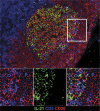Crosstalk Between T and B Cells in the Germinal Center After Transplantation
- PMID: 27906827
- PMCID: PMC5360505
- DOI: 10.1097/TP.0000000000001588
Crosstalk Between T and B Cells in the Germinal Center After Transplantation
Abstract
Crosstalk between B and T cells in transplantation is increasingly recognized as being important in the alloimmune response. T cell activation of B cells occurs by a 3-stage pathway, culminating with costimulation signals. We review the distinct T cell subtypes required for B-cell activation and discuss the formation of the germinal center (GC) after transplantation, with particular reference to the repopulation of the GC after depletional induction, and the subsequent effect of immunosuppressive manipulation of T cell-B cell interactions. In addition, ectopic GCs are seen in transplantation, but their role is not fully understood. Therapeutic options to target T cell-B cell interactions are of considerable interest, both as immunosuppressive tools, and to aid in the further understanding of these important alloimmune mechanisms.
Conflict of interest statement
The authors declare no conflicts of interest.
Figures






References
-
- Kwun J, Knechtle SJ. Overcoming chronic rejection—can it B? Transplantation 2009. 88955–961 - PubMed
-
- van Zelm MC, Reisli I, van der Burg M. An antibody-deficiency syndrome due to mutations in the CD19 gene N Engl J Med 2006. 3541901–1912 - PubMed
-
- Thiel J, Kimmig L, Salzer U. Genetic CD21 deficiency is associated with hypogammaglobulinemia J Allergy Clin Immunol 2012. 129801–810.e6 - PubMed
Publication types
MeSH terms
Substances
Grants and funding
LinkOut - more resources
Full Text Sources
Other Literature Sources
Medical
Miscellaneous

